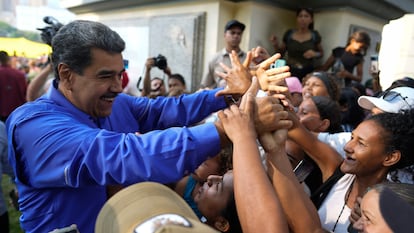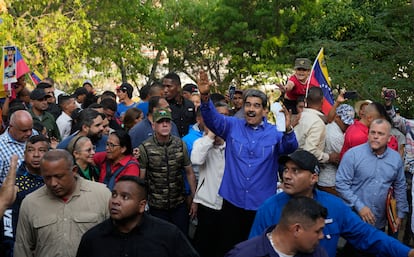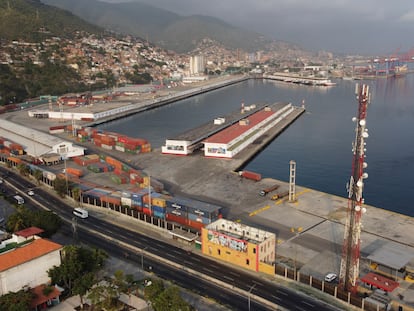Maduro overcomes his fear of being assassinated and leaves Miraflores Palace to campaign in Venezuela
The Venezuelan president, like Hugo Chávez, has denounced multiple plots against him, and has remained in his residence for long periods due to these safety concerns

Nicolás Maduro did not inherit the charisma of Hugo Chávez, but he did inherit his fear of being attacked. Chávez, the ideologue of the Bolivarian revolution, was tortured by the fear that he may be assassinated. A hunch that his safety was in danger was enough for him to cancel a trip to another country or a dinner with foreign leaders. That anxiety could hit him at any time, anywhere. This distrust also affected Chávez’s friend Fidel Castro. In the end, the Venezuelan president was not assassinated, but died from cancer, which left him bedridden in great agony for days. He went to the other world “clinging to Christ,” as Maduro said when announcing his death, on March 5, 2013.
Chávez denounced more than 30 conspiracies against him during his years in power. In some case, he named the suspected perpetrators, but in many others, only vague details were offered. None of them were resolved in a judicial investigation. Maduro was vice president when Chávez died, and was sworn in as acting president. Chávez anointed him as the heir of the revolution. It wasn’t long before Maduro began to feel that the world was conspiring against him. Less than a month after assuming office, in the first week of April, he said: “Because they can’t win the elections, they are looking to shoot me on some street in Venezuela.” That fear has remained with him until today.

However, with the presidential elections coming up on July 28, Maduro has taken to the streets more than usual. A good part of the 11 years he has been in power has been spent in the Miraflores Palace, the seat of government where he sometimes sleeps, which is a veritable bunker. As a result of this seclusion, Maduro — a fierce trade unionist and former bus driver, who was allegedly chosen by Chávez because he was a man of the people — has been accused of losing touch with the Venezuelan people. To silence this criticism, Maduro began making a series of videos in 2017 in which he appeared at the wheel of a vehicle driving across Caracas. The idea was to send the message that Maduro was not afraid of the street protests, where demonstrators were repressed and in many cases killed by the authorities.
Maduro has denounced more than 20 assassination attempts. The most recent attempt on his life took place this year, according to Maduro, who imprisoned opponents, activists and academic experts over their alleged involvement in the plot, despite the lack of evidence. The Venezuelan president has never forgotten what happen on August 4, 2018, when two drones exploded at a military event he was attending. He came out unscathed, but remains fearful of another attack. At the time, he blamed the explosion on the then presidents of the U.S. and Colombia, Donald Trump and Juan Manuel Santos, respectively, as well as various opponents. Later, various confusing information emerged about who had orchestrated the attack. His enemies said he brought it on himself to have an excuse to introduce more radical policies. The case was left in limbo. Maduro now only felt safe within four walls.
While he does occasionally leave Miraflores Palace, his public appearances are only very sporadic. At the beginning of 2023, he traveled to a border crossing with Colombia, and met with Colombian President Gustavo Petro. Maduro got there first, arriving by plane, then by driving the rest of the distance. He had his window down and waved to the people he passed by on the road. However, his meeting with Petro only lasted 20 minutes. A signature, a handshake, a hug and farewell. Could he afford to live in a bubble? The answer is yes, he had someone at his side to help him: Diosdado Cabello.
Cabello — the No.2 of the Chavista regime and first vice president of the United Socialist Party of Venezuela (PSUV, the ruling party) — has been the one crisscrossing the country to rouse support for the government. A common and mistaken belief is that Maduro and Cabello are locked in a cold war for power. This may have been the case in the beginning, before Chávez’s death, but since then, they have each assumed their role and worked in concert. In moments when the revolution is under threat or there is high political conflict, they have remained united.
Cabello gives a press conference every Monday to government-aligned media. On Wednesdays, the state-owned Venezuelan Television broadcasts her feared program Con el mazo dando (Going at it with the Club). Cabello has dedicated herself to working within the party structures, often with military support, lambasting her adversaries in each statement and personally supervising the initiatives to mobilize support, such as the 1x10 strategy, i.e. every Chavista member must mobilize 10 other people close to them.
Relying on the organizational structure of a party embedded in the state and present throughout the country, Cabello has traveled across Venezuela, always speaking of Maduro and never questioning his authority. She has visited Monagas, her native state; as well as the Tuy Valleys, towns in Llanos and the Falcón coast. For some time, Cabello has been giving rallies to “maintain” support for the government: some events are modest affairs, while others have strong attendance. “Hope is in the street, it runs through Venezuela, there is no corner of the country where the voice and embrace of the people is not felt, and it is without a doubt, Chávez, the hope that is reborn in President Nicolás Maduro,” Cabello posted on her Twitter account (now X) at the dawn of a decisive, and most likely tense, election campaign. Information about Cabello’s visits this year is archived on her personal Instagram account.
In recent weeks, Cabello has been on the heels of opposition leader María Corina Machado, organizing rallies in places close to her campaign events. “The opposition is bad when they are in opposition, but worse when they are in government,” she said recently at a rally in the state of Trujillo, shortly before Machado finished a massive tour of the Andean state. “The battered right that today comes out to ask for the vote has a made a deal with the bourgeoisie,” she recently declared. One of her top targets is Edmundo González Urrutia, the opposition’s candidate for president. She has accused him of being “the candidate of imperialism, the elite, the bourgeoisie and the oligarchy.”
But now Cabello is not campaigning alone, Maduro has also taken to the streets in a bid to win over voters. With polls indicating that Chavismo is in danger of losing the election, Maduro has overcome his fear of being assassinated and left Miraflores Palace. According to Maduro’s official Facebook page, he has visited around nine states in just over a week. Many of them have been televised as rallies, but it is difficult to assess how many people are in attendance. Maduro’s communication team makes videos comprised of very short shots that make it impossible to calculate how many people are present. Maduro has been seen on the western shores of Falcón; in the towns of Miranda and Carabobo; in the state of Yaracuy and in the eastern city of Cumaná. If before he lived in seclusion, now he seems to be constantly on the move. Power is at stake.
Sign up for our weekly newsletter to get more English-language news coverage from EL PAÍS USA Edition
Tu suscripción se está usando en otro dispositivo
¿Quieres añadir otro usuario a tu suscripción?
Si continúas leyendo en este dispositivo, no se podrá leer en el otro.
FlechaTu suscripción se está usando en otro dispositivo y solo puedes acceder a EL PAÍS desde un dispositivo a la vez.
Si quieres compartir tu cuenta, cambia tu suscripción a la modalidad Premium, así podrás añadir otro usuario. Cada uno accederá con su propia cuenta de email, lo que os permitirá personalizar vuestra experiencia en EL PAÍS.
¿Tienes una suscripción de empresa? Accede aquí para contratar más cuentas.
En el caso de no saber quién está usando tu cuenta, te recomendamos cambiar tu contraseña aquí.
Si decides continuar compartiendo tu cuenta, este mensaje se mostrará en tu dispositivo y en el de la otra persona que está usando tu cuenta de forma indefinida, afectando a tu experiencia de lectura. Puedes consultar aquí los términos y condiciones de la suscripción digital.
More information
Archived In
Últimas noticias
Petro claims the ELN was the target of US attack in Venezuela
Maduro counterattacks Trump with rhetoric and announces downing of nine drug trafficking aircraft
‘Ecce Homo’: The miraculous disaster that made a small Spanish town famous
Return to sex testing at the Olympics: IOC edges closer to banning transgender women
Most viewed
- Sinaloa Cartel war is taking its toll on Los Chapitos
- Oona Chaplin: ‘I told James Cameron that I was living in a treehouse and starting a permaculture project with a friend’
- Reinhard Genzel, Nobel laureate in physics: ‘One-minute videos will never give you the truth’
- Why the price of coffee has skyrocketed: from Brazilian plantations to specialty coffee houses
- Silver prices are going crazy: This is what’s fueling the rally










































